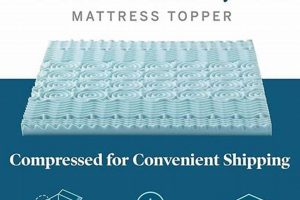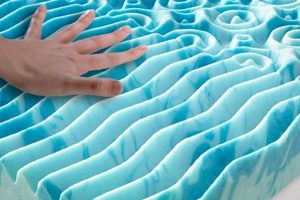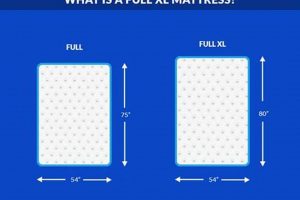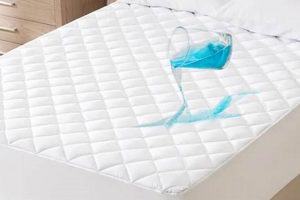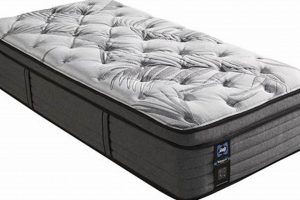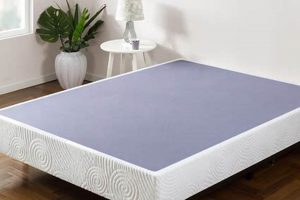A Tempur-Pedic mattress in the twin XL size denotes a specific type of bedding designed with a particular focus on pressure relief and conforming support. It combines the proprietary Tempur material with the extended length of a twin XL, typically intended for single sleepers who require more legroom. These mattresses are known for their visco-elastic properties, adapting to the body’s contours and distributing weight evenly.
The significance of this sleep solution lies in its potential to enhance sleep quality and reduce discomfort. Its unique construction offers benefits such as minimized motion transfer, improved spinal alignment, and reduced pressure points. Historically, Tempur-Pedic’s innovative use of memory foam, originally developed by NASA, revolutionized the mattress industry and set a new standard for comfort and support. The extended length of the twin XL size caters to taller individuals, ensuring full-body support and preventing discomfort caused by hanging feet.
This article will delve into the specific characteristics of these mattresses, examining the construction materials, typical features, and the advantages they offer to different types of sleepers. The discussion will also cover factors to consider when selecting this type of mattress, including firmness levels, potential drawbacks, and maintenance recommendations.
Guidance on Utilizing a Tempur-Pedic Mattress, Twin XL Size
This section provides essential information to maximize the lifespan and benefits of a Tempur-Pedic mattress in the twin XL configuration.
Tip 1: Select Appropriate Bed Frame Support: Ensure the bed frame provides adequate support across the entire surface. Slatted frames should have slats spaced no more than 4 inches apart to prevent sagging. Platform beds are also a suitable option.
Tip 2: Employ a Mattress Protector: Utilize a waterproof and breathable mattress protector. This safeguards against spills, stains, and allergens, extending the mattress’s lifespan and maintaining hygiene.
Tip 3: Rotate Regularly: Rotate the mattress 180 degrees every six months to promote even wear and prevent body impressions. Avoid flipping the mattress, as it is designed with specific layers.
Tip 4: Maintain a Consistent Room Temperature: Memory foam’s properties are temperature-sensitive. Maintaining a room temperature between 65-75F (18-24C) will optimize its conforming characteristics and provide consistent comfort.
Tip 5: Avoid Excessive Direct Sunlight: Prolonged exposure to direct sunlight can degrade the memory foam. Position the bed away from windows or use window coverings to minimize UV exposure.
Tip 6: Follow Cleaning Instructions: Spot clean stains with a mild detergent and water. Avoid using harsh chemicals or saturating the mattress. Refer to the manufacturer’s guidelines for specific cleaning recommendations.
Tip 7: Utilize Proper Lifting Techniques: When moving the mattress, use proper lifting techniques or seek assistance to prevent damage. Avoid bending or folding the mattress excessively.
Adhering to these recommendations will preserve the structural integrity, enhance the comfort, and extend the useful life of a Tempur-Pedic mattress, twin XL size, ensuring optimal sleep quality.
The concluding section will offer a summary of the key considerations discussed and provide final recommendations for selecting and maintaining this type of mattress.
1. Dimensions
The dimensions of a Tempur-Pedic mattress, particularly in the twin XL size, are a fundamental attribute directly influencing its intended use and suitability for specific individuals. The twin XL designation denotes a mattress designed for single sleepers, typically taller individuals, who require additional length. Standard dimensions for a twin XL mattress are approximately 38 inches in width and 80 inches in length. These measurements are critical because they determine the surface area available for a sleeper and dictate whether the mattress can accommodate the user’s height comfortably. Inadequate length can lead to discomfort, disrupt sleep, and negatively impact spinal alignment. This is particularly pertinent given Tempur-Pedic’s focus on providing pressure relief and support.
Real-life examples highlight the practical significance of these dimensions. A college student residing in a dormitory setting often utilizes a twin XL mattress due to space constraints. The extended length accommodates taller students who might find a standard twin mattress inadequate. Furthermore, the precise dimensions of the mattress must correspond to the dimensions of the bed frame to ensure proper support and prevent damage to the mattress. Failing to account for these dimensional specifications can result in compromised comfort and reduced product lifespan. Selecting appropriate bed sheets and bedding accessories also hinges on accurate dimension awareness.
In summary, the dimensions of a Tempur-Pedic mattress, twin XL, represent a key factor in its utility and effectiveness. Understanding these measurements and their implications is crucial for selecting the correct mattress to provide optimal support and comfort. Neglecting this aspect can lead to suboptimal sleep quality and reduced satisfaction. Therefore, confirming the precise dimensions of both the mattress and the intended bed frame is essential before making a purchase.
2. Material Composition
The material composition of a Tempur-Pedic mattress, particularly in the twin XL size, is paramount to understanding its performance characteristics. The specific materials used directly influence factors such as pressure relief, support, temperature regulation, and durability, ultimately determining the user’s sleep experience.
- TEMPUR Material
The core component is the proprietary TEMPUR material, a viscoelastic polyurethane foam originally developed by NASA. This material is engineered to conform to the body’s shape, distributing weight evenly and minimizing pressure points. The density and composition of TEMPUR material vary across different Tempur-Pedic mattress models, influencing firmness and feel. For instance, a TEMPUR-Cloud mattress utilizes a softer formulation for enhanced comfort, while a TEMPUR-Adapt mattress offers a balance of support and adaptability. In a twin XL size, this material ensures consistent support across the extended length, accommodating taller individuals.
- Support Core
Beneath the TEMPUR material lies a support core, typically constructed from high-density polyurethane foam. This core provides the necessary structural support to maintain spinal alignment and prevent sagging. The density and thickness of the support core contribute to the overall firmness and longevity of the mattress. A firmer support core is often used in models designed for back or stomach sleepers, while a more flexible core may be present in models catering to side sleepers. The support core is crucial for preventing the “hammocking” effect that can occur in all-foam mattresses, ensuring proper posture throughout the night.
- Cover Materials
The mattress cover plays a significant role in temperature regulation and overall comfort. Tempur-Pedic mattresses often feature covers made from breathable fabrics like polyester blends or specialty materials designed to wick away moisture. Some covers incorporate cooling technologies, such as phase-change materials, to help regulate body temperature and prevent overheating. The cover material also impacts the tactile feel of the mattress, with some offering a plush, soft surface while others provide a more taut and supportive feel. Durability and resistance to allergens are additional considerations in cover material selection.
- Additional Layers (Optional)
Certain Tempur-Pedic models may incorporate additional layers to enhance specific performance aspects. These layers can include gel-infused memory foam for enhanced cooling, or specialized transition layers designed to improve pressure relief and conformability. The presence and composition of these additional layers contribute to the overall comfort profile and influence the mattress’s suitability for different sleep preferences. In the context of a twin XL, these layers are proportionally adjusted to ensure consistent performance across the entire surface area of the mattress.
In conclusion, the material composition of a Tempur-Pedic mattress, twin XL, is a carefully engineered blend of materials designed to provide optimal support, pressure relief, and comfort. Understanding the roles and properties of each component is essential for selecting a mattress that aligns with individual sleep needs and preferences. The specific combination of TEMPUR material, support core, cover material, and optional additional layers determines the overall performance and longevity of the mattress, impacting the quality of sleep experienced by the user.
3. Support System
The support system within a Tempur-Pedic mattress, specifically in the twin XL configuration, is a critical element that dictates its overall performance and ability to provide proper spinal alignment and pressure relief. It underpins the comfort layers and ensures the mattress maintains its structural integrity over time. The following outlines key facets of the support system’s role.
- High-Density Foam Core
The foundation of most Tempur-Pedic mattresses is a high-density foam core. This layer is designed to provide the primary support, preventing sagging and maintaining the mattress’s shape. For example, a taller individual using a twin XL mattress requires robust support to ensure their spine remains aligned throughout the night, preventing back pain. The density of this core directly impacts the mattress’s longevity and its ability to withstand consistent weight distribution.
- Base Layer Construction
The base layer often incorporates features that enhance airflow and stability. Some models utilize channels or contours to promote ventilation, reducing heat buildup and improving sleep comfort. This is particularly relevant in a twin XL mattress, where a single sleeper’s body heat can concentrate in a smaller area. A well-constructed base layer also provides a stable foundation for the comfort layers above, preventing premature wear.
- Edge Support Systems
Edge support systems are designed to reinforce the perimeter of the mattress, preventing the edges from collapsing under pressure. This is especially important for individuals who tend to sleep near the edge of the bed or who use the edge for support when sitting. Without adequate edge support, the sleeping surface is reduced, and the mattress may exhibit uneven wear. A robust edge support system contributes to the overall durability and usable surface area of the twin XL Tempur-Pedic mattress.
- Integration with Comfort Layers
The support system must effectively integrate with the comfort layers, typically composed of TEMPUR material. The transition between the support core and the comfort layers is crucial for providing both support and pressure relief. A well-designed mattress will ensure that the support system works in tandem with the comfort layers to contour to the body’s shape while maintaining proper spinal alignment. This synergistic relationship is key to achieving the optimal balance of comfort and support that Tempur-Pedic mattresses are known for.
In summary, the support system within a Tempur-Pedic twin XL mattress is not merely a structural component but an integral part of the overall sleep experience. Its design and materials directly influence the mattress’s ability to provide proper spinal alignment, prevent sagging, and maintain consistent comfort over time. Understanding the nuances of the support system is crucial for selecting a mattress that meets individual sleep needs and preferences.
4. Temperature Sensitivity
Temperature sensitivity is a defining characteristic of Tempur-Pedic mattresses, particularly relevant in the twin XL size, influencing both comfort and performance. The visco-elastic properties of the TEMPUR material are inherently affected by temperature, impacting its firmness and conforming ability. This sensitivity must be understood to optimize the sleep experience.
- Firmness Variation
The TEMPUR material becomes firmer at lower temperatures and softer at higher temperatures. During colder months, a twin XL Tempur-Pedic mattress may initially feel firmer upon lying down, gradually softening as it absorbs body heat. Conversely, in warmer climates, the mattress may feel softer from the outset. This variance can impact the perceived level of support and pressure relief, potentially requiring adjustment in bedding or room temperature to achieve consistent comfort.
- Heat Retention
Due to its dense composition, TEMPUR material has a tendency to retain heat, which can be a concern for individuals who sleep hot. While Tempur-Pedic has introduced cooling technologies in some models, temperature regulation remains a key consideration. The twin XL size, being smaller, concentrates body heat more than larger mattresses, potentially exacerbating this issue. Utilizing breathable bedding and maintaining a cooler room temperature can mitigate heat retention.
- Impact on Conformability
The conforming ability of the TEMPUR material, its ability to mold to the body’s contours, is directly influenced by temperature. As the mattress warms, it becomes more pliable, enhancing pressure relief and spinal alignment. However, if the mattress remains too firm due to low temperatures, its conforming ability is reduced, potentially leading to discomfort. Optimizing the sleep environment ensures the TEMPUR material can effectively adapt to the body.
- Influence of Climate
Geographic location and seasonal changes can significantly impact the performance of a Tempur-Pedic twin XL mattress. In humid climates, the mattress may retain moisture, affecting its overall feel and potentially promoting the growth of mold or mildew. In arid climates, the mattress may dry out, leading to premature wear. Maintaining proper ventilation and humidity control in the bedroom can prolong the life and maintain the comfort of the mattress.
The temperature sensitivity of a Tempur-Pedic twin XL mattress is a crucial factor affecting its performance and user satisfaction. While the TEMPUR material offers unique benefits in terms of pressure relief and support, its responsiveness to temperature requires proactive management to ensure a consistently comfortable sleep environment. Understanding and addressing these temperature-related aspects is essential for optimizing the benefits of this mattress type.
5. Motion Isolation
Motion isolation, the ability of a mattress to minimize the transfer of movement from one area to another, is a significant attribute of Tempur-Pedic mattresses, particularly in the twin XL size. This characteristic directly impacts the sleep quality of individuals sharing a bed, though its benefits extend to single sleepers as well. The primary cause of motion isolation in Tempur-Pedic mattresses is the unique viscoelastic nature of the TEMPUR material. This material absorbs and dissipates energy rather than transmitting it across the mattress surface. The importance of motion isolation as a component of a Tempur-Pedic mattress is especially pronounced in situations where one sleeper is restless or has a different sleep schedule than their partner. Without effective motion isolation, disturbances caused by movement can lead to disrupted sleep cycles and decreased overall restfulness.
The practical significance of understanding motion isolation in the context of a Tempur-Pedic twin XL mattress is illustrated by considering its common use in college dormitories or smaller living spaces. While a twin XL mattress is typically designed for a single occupant, its motion isolation properties can still be valuable. For instance, if a student shares a room and their roommate moves around at night, the Tempur-Pedic mattress’s motion-isolating capabilities can help minimize disturbance and preserve the student’s sleep quality. Furthermore, individuals who themselves tend to toss and turn during the night may find that the mattress’s ability to absorb movement reduces their own self-disturbance, promoting a more stable sleep environment. Another contributing factor to the mattresses effectiveness is the high-density foam core, which stabilizes the upper comfort layers. Without a high-quality core, the motion isolation benefits would be greatly diminished.
In conclusion, motion isolation is a key attribute of Tempur-Pedic mattresses that significantly enhances sleep quality by minimizing the transfer of movement. While often associated with shared beds, its benefits also extend to single sleepers seeking to reduce self-disturbance. The viscoelastic properties of the TEMPUR material, combined with a stable core, provide the basis for this feature. Challenges may arise in assessing motion isolation, but the understanding of its underlying principles is critical in evaluating the suitability of a Tempur-Pedic mattress, ensuring optimal rest even in potentially disruptive environments.
6. Sleep Position Suitability
The correlation between sleep position suitability and a Tempur-Pedic mattress in the twin XL size is a central determinant of sleep quality. A sleeper’s preferred positionside, back, or stomachdictates the areas of the body that require the most support and pressure relief. A twin XL Tempur-Pedic mattress, with its visco-elastic properties, can conform to the body’s contours, providing targeted support. However, the effectiveness of this support hinges on whether the mattress is appropriately matched to the individual’s sleep position. A mismatch can lead to spinal misalignment, pressure point discomfort, and disrupted sleep. Therefore, understanding how different sleep positions interact with the mattress’s features is crucial for optimizing its benefits. The firmness and construction of the mattress must complement the sleeper’s habitual posture to ensure proper spinal alignment and minimize discomfort.
For example, a side sleeper typically requires a softer mattress that allows the shoulder and hip to sink in, relieving pressure on these joints. A Tempur-Pedic twin XL with a plush or medium firmness level may be suitable in this case. Conversely, a back sleeper generally benefits from a firmer mattress that provides adequate support to the lumbar region, preventing the spine from sagging. A firmer Tempur-Pedic option might be more appropriate. A stomach sleeper often needs the firmest support to prevent excessive arching of the back, which can lead to lower back pain. Although stomach sleeping is generally discouraged due to its potential for spinal strain, a very firm Tempur-Pedic mattress might be considered, though alternative sleep positions are typically recommended. The practical implication of this understanding is that a careful assessment of the individual’s sleep position is essential before selecting a Tempur-Pedic twin XL mattress. This involves considering body weight, spinal alignment needs, and personal preferences for firmness and feel.
In summary, sleep position suitability is a fundamental factor in determining the effectiveness of a Tempur-Pedic twin XL mattress. The mattress’s ability to conform to the body and provide targeted support is contingent on aligning its firmness and construction with the individual’s preferred sleep posture. While Tempur-Pedic mattresses offer inherent advantages in terms of pressure relief and motion isolation, these benefits are maximized when the mattress is appropriately matched to the sleeper’s position. Ignoring this aspect can result in suboptimal sleep quality and discomfort. Therefore, considering sleep position is a critical step in selecting a Tempur-Pedic mattress that promotes proper spinal alignment, pressure relief, and restful sleep.
Frequently Asked Questions
This section addresses common inquiries concerning the Tempur-Pedic mattress in the twin XL size. The information provided aims to clarify typical concerns and misconceptions.
Question 1: What are the precise dimensions of a Tempur-Pedic mattress in the twin XL size?
A Tempur-Pedic mattress designated as twin XL typically measures approximately 38 inches in width and 80 inches in length. Variations of up to one inch may occur due to manufacturing tolerances.
Question 2: Is a specific type of bed frame required for a Tempur-Pedic mattress, twin XL?
The bed frame should provide adequate support across the entire surface. Slatted frames are acceptable if the slats are spaced no more than 4 inches apart. Platform beds are also suitable. Insufficient support can lead to mattress sagging and premature wear.
Question 3: What is the typical lifespan of a Tempur-Pedic mattress, twin XL?
With proper care, a Tempur-Pedic mattress generally has a lifespan of 7 to 10 years. Factors such as usage, weight distribution, and maintenance practices influence longevity.
Question 4: Are Tempur-Pedic mattresses, twin XL, suitable for individuals with back pain?
The visco-elastic properties of the TEMPUR material can provide pressure relief and spinal support, potentially benefiting individuals with back pain. However, individual preferences for firmness and support levels vary. Consultation with a healthcare professional is advisable.
Question 5: How should a Tempur-Pedic mattress, twin XL, be cleaned?
Spot cleaning with a mild detergent and water is recommended. Harsh chemicals and saturation should be avoided. Refer to the manufacturer’s guidelines for specific cleaning instructions. Professional cleaning services may be considered for extensive stains.
Question 6: What is the recommended weight capacity for a Tempur-Pedic mattress, twin XL?
The recommended weight capacity generally ranges between 250 and 300 pounds. Exceeding this limit can compromise the mattress’s support and durability.
These responses offer a concise overview of prevalent concerns regarding Tempur-Pedic mattresses in the twin XL configuration. Further research or consultation with a qualified professional may be necessary for specific inquiries.
The subsequent section will provide a comprehensive summary of the key points discussed, followed by conclusive recommendations.
Conclusion
This analysis has explored the defining characteristics of the Tempur-Pedic mattress, twin XL, encompassing its dimensions, material composition, support system, temperature sensitivity, motion isolation capabilities, and suitability for various sleep positions. The investigation revealed the intricate relationship between these factors and their collective impact on sleep quality, durability, and user satisfaction. Emphasis was placed on understanding how the mattress’s visco-elastic properties and construction contribute to pressure relief, spinal alignment, and overall comfort.
The decision to invest in a Tempur-Pedic mattress, twin XL, necessitates a comprehensive evaluation of individual sleep needs and preferences, carefully considering the mattress’s inherent limitations and required maintenance. Selecting an appropriate mattress is essential for achieving optimal rest and long-term well-being. It’s recommended to consult with sleep experts and conduct thorough research before committing to a purchase.


